Chicken Pox (Varicella zoster virus or VZV) was a common childhood disease where the kids present with an itchy slightly raised and scaly rash. Most parents today remember their encounter with chickenpox or have been told the stories behind the chickenpox scars they carry.
However, most people are not aware that having chickenpox isn’t the illnesses last hoorah.
Unlike many illnesses, the chickenpox virus actually never leaves the infected patient, even after a full recovery. The VZV hides (hibernates) in the spinal nerve (dorsal nerve roots) where it may reactivate again when the immune system declines with the host’s aging or increasing stress.
After a case of chickenpox, the level of immunity to VZV gradually declines over time. Eventually, the immunity falls low enough to allow reactivation of VZV from hibernation. The reactivation occurs along one side of the spinal nerve root which explains the reason why Zoster always only appears on one side of the body.
A patient’s stress and exposure to cold temperatures may trigger Zoster reactivation to occur in a condition called shingles. The VZV typically travels along the spinal nerve fibers to the skin and causes the physical signs of a rash to appear. It may be several days before the rash appears after one experiences the pain or itching.
The common areas affected by reactivation of shingles are the face along with the distribution of the facial nerves (trigeminal nerves), the upper back and flank areas of the trunk. The blisters usually evolve into fluid-filled vesicles. These blisters can shed the VZV until they scab over. This may take up to ten days or longer to occur.
Patients should avoid contact with persons who have not had chickenpox.
1 in 3 Americans will have shingles during their lifetime and the rate is increasing.
 There are approximately 1 million cases of shingles each year in the United States, about half of these occur in persons over the age of sixty.
There are approximately 1 million cases of shingles each year in the United States, about half of these occur in persons over the age of sixty.
Complications occur in about half of the older patients with shingles. Some of these complications can be serious that may permanently affect eyesight, skin infections, or on-going pain. These long-term complications may have a substantial negative effect on quality of life among the elderly.
In 2006 FDA approved a VZV vaccination for the prevention of shingles. The American College of Immunization Practices recommends routine vaccination of VZV vaccine in patients 60 years or older. There are also proven scientific studies that deter Shingles and its complications among those vaccinated while in their fifties.

